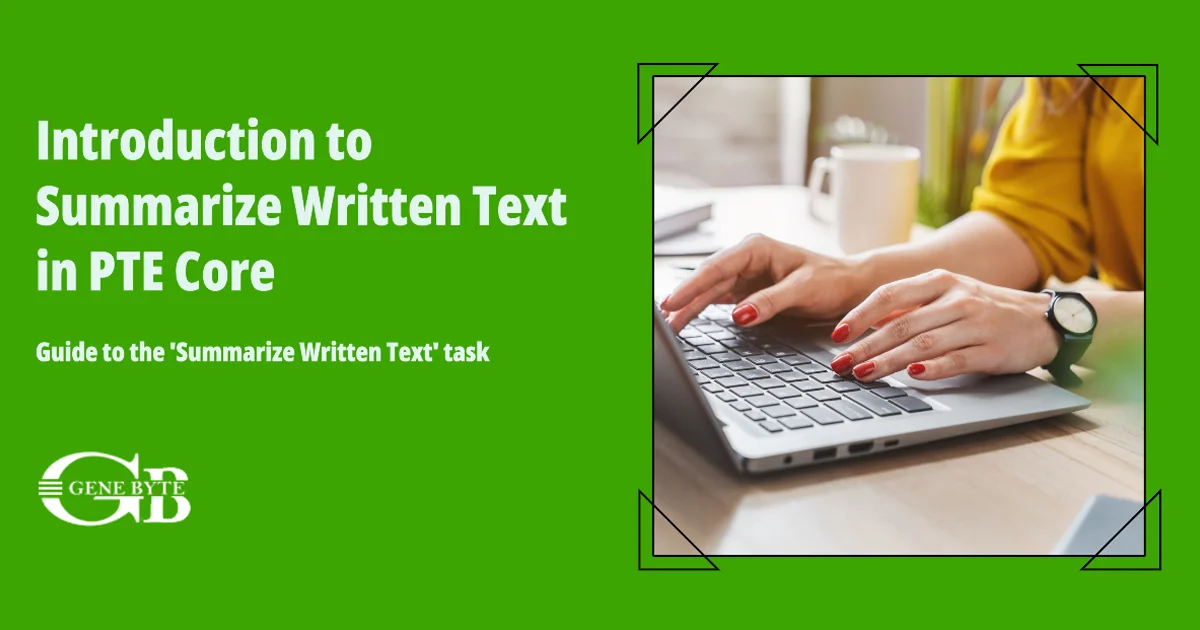PTE Core Insights:
Summarize Written Text for Educators
A Teacher's Guide to PTE Core Summarize Written Text

"Transforming PTE Core prep with innovation, one summary at a time."
At Genebyte, we understand the critical role teachers play in guiding students through the PTE Core, especially the Summarize Written Text (SWT) section. This section tests students' comprehension and summarization skills, blending reading and writing in a unique challenge.
Key Points for Teachers:
- The SWT task requires condensing a passage into a single sentence, highlighting main ideas succinctly.
- Teachers are pivotal in preparing students for this section, fostering analytical skills and writing precision.
- Genebyte's platform offers tools to support teaching strategies, providing insights into student performance for targeted improvement.
Our Support for Educators:
Genebyte is dedicated to enhancing teaching methods with technology, offering an AI-powered platform that aligns with teaching goals, improving student outcomes and operational efficiency.
Importance of SWT:
- It assesses a student's ability to distill complex information, reflecting real-world English proficiency.
- Success in this section can significantly impact a student's overall PTE Core performance.
Genebyte collaborates with educators to ensure students are equipped with the necessary skills for the PTE Core, fostering a supportive learning environment that leads to academic and professional success.

Introduction to the PTE Core Summarize Written Text (SWT)
In the landscape of English language proficiency assessments, the Summarize Written Text (SWT) task of the Pearson Test of English's Core exam stands as a cornerstone for evaluating a candidate's comprehensive command over the English language. This task, integral to the PTE Writing section, challenges test-takers to condense a lengthy passage into a succinct summary, encapsulating the main ideas in a limited number of words. This exercise not only assesses a candidate's reading comprehension but also their ability to synthesize information and articulate it concisely, showcasing a nuanced mastery of English writing.
The Dual Challenge of SWT
The SWT task presents a unique dual challenge: understanding a complex text and then expressing its essence in a condensed form without losing the original meaning. Candidates are given a text of up to 200 words and are required to craft a summary in just one sentence, ranging between 25 to 50 words. This requires not just a deep understanding of the content but also a strategic choice of language to preserve the core message. It's a task that mirrors real-world situations where clarity and brevity are paramount, from executive summaries in business reports to communicating key project updates.
Why SWT Matters
The significance of the SWT task extends beyond the exam room. It embodies the essential skill of effective communication in academic, professional, and everyday contexts. In today's information-rich world, the ability to distill complex information into digestible, actionable insights is invaluable. Thus, SWT scores are not just numbers; they reflect a candidate's readiness to engage with and contribute to English-speaking environments critically and creatively.

The Nature of the SWT Task in PTE Core
Unveiling the SWT Task
The Writing section begins with SWT, right after Answer Short Question. It's a component designed to assess both reading and writing skills within a singular activity. This task challenges candidates to condense a detailed passage into a succinct summary, effectively testing their ability to comprehend complex information and articulate it concisely.
Task Overview
- Reading and Writing a Summary: Candidates are presented with a passage that requires a keen understanding before being distilled into a summary.
- Prompt Length: Up to 200 words, providing a substantial amount of information that needs to be synthesized.
- Answer Length: The summary must be between 25 to 50 words, necessitating precision and clarity.
- Skills Assessed: A dual assessment of Reading and Writing abilities.
- Time Allocated: 10 minutes, which includes reading the passage, planning the summary, writing, and reviewing.
The Dual Challenge
The SWT task embodies a dual challenge that goes beyond mere test-taking. It is a real-world skill that spans academic, professional, and personal arenas.
- Comprehension: Before one can summarize, one must fully understand the passage's content, requiring active reading skills and an analytical mindset.
- Conciseness: The art of being concise while maintaining the passage's core message tests a candidate's linguistic efficiency and decision-making in choosing what to include and what to omit.

Significance of SWT for Test Takers
The Reading Summary task in the PTE Core not only serves as a pivotal component of the Writing Section but also significantly influences the reading score. This underscores its critical role in shaping a test taker's overall performance in the PTE Core examination. Understanding the dual significance of SWT can empower educators to refine their teaching strategies, enabling students to maximize their proficiency in both domains.
Importance in Writing Score
- Assessment of Synthesis Skills: SWT evaluates a candidate's ability to distill complex information into a concise summary, a skill paramount in academic and professional writing. This task directly impacts the writing score by assessing clarity, coherence, and conciseness—key metrics of effective writing.
- Emphasis on Language Precision: The constrained answer length necessitates precise language use, testing a candidate's ability to choose the most effective words to convey meaning. Mastery in this area significantly boosts the writing score, reflecting a high level of linguistic proficiency.
Importance in Reading Score
- Comprehension and Analysis: Successfully summarizing a text presupposes a deep understanding of its content. The SWT task indirectly gauges reading comprehension by requiring test-takers to identify and articulate the main ideas, contributing to the reading score.
- Critical Engagement with Text: Beyond mere comprehension, SWT encourages a critical engagement with the material, prompting test takers to analyze the significance of information within a broader context. This analytical approach enhances reading skills, underscoring the task's importance in the reading score.
Impact on Overall PTE Core Performance
The SWT task stands as a cornerstone of the PTE Core, significantly influencing overall test performance. Its dual contribution to both writing and reading scores highlights the integrated nature of language proficiency assessed by the PTE Core. Excelling in SWT can thus markedly elevate a candidate's composite score, reflecting a comprehensive mastery of English.
- Holistic Skill Development: Preparation for SWT inherently fosters a holistic development of language skills, encouraging a balanced approach to reading and writing preparation.
- Strategic Focus for Educators: As with RWFIB, recognizing the SWT's significance enables educators to strategically focus their teaching efforts, guiding students to allocate their study time effectively to hone both writing and reading skills.

SWT from a Teacher's Perspective
Grasping the Challenges
In the journey of mastering the Summarize Written Text (SWT) task within the PTE Core, students often encounter a multifaceted set of challenges. From the teacher's vantage point, understanding these hurdles is the first step toward crafting effective learning strategies that address each student's unique needs.
- Identifying Key Information: One of the most common obstacles students face is distinguishing the main points from secondary details in the passage. This skill is crucial for effective summarization and requires a nuanced understanding of the text.
- Distilling Complex Texts: The essence of SWT lies in condensing the given text into a clear, concise summary. Students must learn to express complex ideas succinctly, preserving the original meaning without oversimplification.
- Use of FANBOYS (Coordinating Conjunctions): Mastery over coordinating conjunctions (For, And, Nor, But, Or, Yet, So) plays a pivotal role in crafting coherent summaries. These linguistic tools help in connecting ideas smoothly, enhancing the readability of the summary.
The Art of Summarization
Teaching summarization is not just about imparting techniques; it's about nurturing a mindset that appreciates clarity, coherence, and brevity in writing. Here's how educators can address the challenges and enhance students' summarization skills:
-
Strategies for Key Information Identification:
- Teach students to look for thematic sentences in paragraphs, typically found at the beginning or end.
- Encourage active reading practices, such as note-taking and questioning the text, to engage with the material deeply.
-
Techniques for Distilling Texts:
- Introduce the concept of "information hierarchy" to help students prioritize ideas based on their relevance and significance.
- Employ exercises that focus on rewriting paragraphs in fewer words, emphasizing the retention of core ideas.
-
Utilizing Coordinating Conjunctions:
- Incorporate exercises that involve sentence combining using FANBOYS, fostering a nuanced understanding of how different ideas can be connected logically and smoothly.
- Offer practice sessions that challenge students to use these conjunctions creatively to maintain the flow of their summaries.

Leveraging Technology to Enhance SWT Preparation
In the realm of PTE Core preparation, the Summarize Written Text (SWT) task poses a unique challenge, demanding a blend of comprehension and conciseness from candidates. Recognizing the intricacies of mastering SWT, Genebyte has pioneered a technology-driven approach to revolutionize preparation strategies. Our platform harnesses the power of artificial intelligence to offer a comprehensive solution tailored to the needs of both educators and students, particularly in enhancing SWT preparation.
Automated Feedback for Immediate Improvement
- Instant Analysis: Upon submission of practice summaries, our platform utilizes advanced algorithms to provide immediate, detailed feedback. This includes evaluations of clarity, grammatical accuracy, and adherence to the summary's required length.
- Focused Feedback: Highlighting specific areas for improvement, our feedback system guides students in refining their summarization skills, offering actionable insights that lead to tangible progress.
Customized Practice Sessions Based on AI Analysis
- Personalized Learning Paths: Leveraging AI, Genebyte identifies each student's strengths and areas for growth, customizing practice sessions that target individual learning needs. This ensures that every moment spent on our platform contributes directly to enhancing their summarization capabilities.
- Progress Tracking: Teachers gain access to in-depth analytics on student performance, enabling them to monitor advancements and adjust teaching strategies accordingly.
The Role of Templates and Tricks in Simplifying SWT Tasks
- Strategic Use of Templates: While templates can offer a foundational structure for summaries, their utility should be approached with caution. Genebyte advocates for a balanced use of templates, emphasizing their role in teaching the fundamentals of summarization rather than as a one-size-fits-all solution.
- Effective Employment of Tricks: Tricks, or strategic approaches to common summarization challenges, can be powerful tools when used appropriately. Our platform offers guidance on employing these techniques judiciously, ensuring they enhance, rather than detract from, the quality of summaries.
Encouraging Authenticity in Summarization
- Dissuading Overreliance on Templates: Genebyte's educational philosophy stresses the importance of developing genuine summarization skills. We encourage educators to use templates as a teaching aid to introduce the concept of summarization, gradually moving students towards crafting summaries independently.
- Cultivating Critical Thinking: By integrating exercises that foster critical engagement with texts, we help students move beyond templates, cultivating a deeper understanding and the ability to summarize texts authentically.

Genebyte's Solutions for Teaching Reading Summary
In the quest to master the SWT task within the PTE Core test, the integration of Genebyte's B2B SaaS solution emerges as a transformative approach for coaching institutes. Our platform is specifically designed to address the challenges educators face in teaching summarization, providing a suite of tools that elevate both teaching methodologies and student outcomes.
Utilizing Genebyte's Solution in Teaching Summarization
- Tailored Learning Experiences: Genebyte's platform employs advanced algorithms to create personalized learning experiences for each student. By analyzing individual performance on SWT tasks, our system customizes practice sessions that target specific areas of improvement, ensuring a focused and efficient learning journey.
- Interactive Practice Sessions: Our platform offers a rich repository of practice materials, including passages that mirror the complexity and style of texts found in the PTE Core exam. This enables students to gain familiarity with the exam format and develop confidence in their summarization skills.
Benefits of Genebyte's Resources for Educators
- Comprehensive Performance Insights: Genebyte provides educators with detailed analytics on student performance, highlighting strengths and identifying areas that require additional focus. This data-driven approach enables teachers to make informed decisions in their instruction, tailoring their teaching strategies to meet the unique needs of each student.
- Collaborative Learning Environment: Our platform fosters a collaborative learning environment, allowing educators to share resources, strategies, and insights. This community aspect encourages a shared commitment to excellence in English language teaching and learning.
Enhancing Student Engagement and Understanding
- Engagement Through Gamification: Genebyte incorporates gamification elements into the learning process, making practice sessions engaging and motivating for students. This approach encourages regular practice and sustained effort, key factors in mastering summarization skills.
- Deepening Understanding with Interactive Feedback: Beyond automated feedback, Genebyte's platform facilitates interactive sessions where students can receive direct feedback from educators. This immediate, constructive feedback helps students refine their summaries, deepening their understanding of effective summarization techniques.
Elevating Teaching and Learning with Genebyte
Genebyte's innovative B2B SaaS solution is not merely a tool for exam preparation; it's a catalyst for educational transformation. By integrating our platform into their curriculum, coaching institutes can elevate their teaching methods, enhance student engagement, and ultimately improve outcomes on the SWT task and beyond. Our commitment to leveraging technology for education positions Genebyte as an indispensable partner for coaching institutes aiming to excel in PTE Core preparation.

Actionable Insights for Educators
As we conclude this exploration into the SWT task of the PTE Core and the transformative impact of Genebyte's solutions on teaching methodologies, let's encapsulate the actionable insights and recommendations for educators striving for excellence in English language instruction.
Embrace Technology-Driven Learning
Integrating Genebyte's B2B SaaS platform into your teaching practice represents a pivotal step towards elevating the learning experience. Our technology not only personalizes the educational journey for each student but also empowers educators with robust tools to enhance the teaching of the SWT task.
- Foster Critical Engagement: Encourage your students to engage critically with texts, prioritizing comprehension and analytical skills. Utilize Genebyte's rich repository of practice materials to expose them to a variety of texts, mirroring the diversity and complexity of the PTE Core test.
- Cultivate Conciseness and Clarity: Teach your students the art of conciseness without compromise on content. Through Genebyte's feedback mechanisms, students can learn to distill complex ideas into clear, concise summaries, a skill invaluable within and beyond the exam context.
- Leverage Collaborative Insights: Benefit from the collaborative learning environment fostered by Genebyte, where educators share strategies, insights, and successes. This community approach amplifies individual efforts, driving collective success.
Engage with Genebyte
To fully harness the potential of Genebyte's platform in revolutionizing the PTE Core English test preparation, we invite you to explore further. Whether you're interested in a trial, seeking a demonstration, or simply wish to learn more about how our solution aligns with your educational goals, our team is ready to assist. In mastering the SWT task, the synergy between dedicated educators and Genebyte's innovative solutions creates an environment where students not only succeed in their exams but also acquire lifelong skills in effective communication. Following the SWT, the student will get the Email task instead of the Essay.
Visit our website, reach out for a demo, and join the growing community of educators who choose Genebyte as their partner in achieving teaching and learning excellence.
Frequently Asked Questions
To effectively identify key points, focus on the main idea presented in the introduction and conclusion, and pay attention to recurring themes and arguments within the body. Practice active reading by noting down significant points as you read.
Best practices include understanding the overall theme before starting to write, using your own words to express the main ideas, and ensuring your summary is coherent by logically connecting the key points.
A rich vocabulary allows for precise expression, enabling test-takers to succinctly convey complex ideas and nuances of the original text in their summaries.
To avoid redundancy, focus on synthesizing ideas rather than repeating information. Use synonyms and paraphrase effectively to convey the text's main points without unnecessary repetition.
Practice is crucial as it helps familiarize test-takers with different text types and themes, improves summarization skills, and builds confidence in identifying key points and condensing information effectively.
Yes, techniques may vary depending on the text's structure and content. For example, summarizing a narrative requires focusing on the plot and characters, while informational texts require highlighting the main arguments or findings.
The SWT task significantly impacts both the reading and writing scores by assessing a candidate's ability to comprehend and concisely articulate the main ideas of a text, reflecting their overall English proficiency.
While the response is typically expected to be a single sentence, clarity and coherence are paramount. Ensure your summary is well-structured and accurately conveys the text's main points within the prescribed word limit.
Proper punctuation enhances the readability and coherence of summaries, helping to clearly delineate ideas and ensuring that the summary accurately reflects the original text's meaning.
Effective strategies include reviewing summaries for clarity and coherence, practicing with a variety of texts to improve adaptability, and seeking feedback to identify areas for improvement.
Balancing detail and brevity involves selecting only the most critical information that contributes to the text's main idea and articulating it in a concise manner, avoiding unnecessary details.
A faster reading speed allows for more time to analyze, plan, and write the summary, contributing to a more thoughtful and well-structured response within the allocated time.